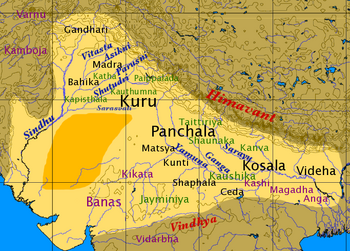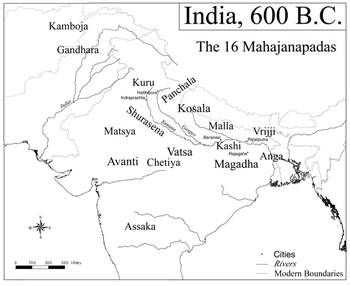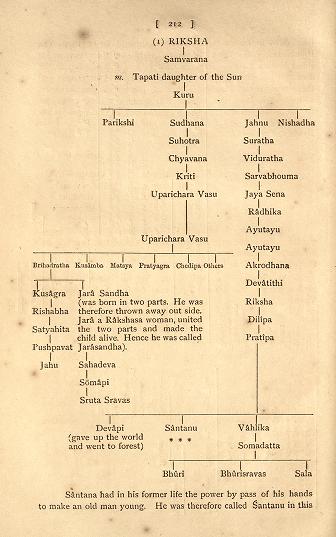Kuru: Difference between revisions
No edit summary |
|||
| Line 41: | Line 41: | ||
आज भी इस वंश के बहुत जाट हैं जिनका गोत्र कुरु-कुरुवंशी-कौरव है। | आज भी इस वंश के बहुत जाट हैं जिनका गोत्र कुरु-कुरुवंशी-कौरव है। | ||
'''[[Kuru|कुरुवंश]]''' - कुरु जाटों का राज्य उत्तरी कुरु ([[Siberia|साइबेरिया]] में) देश पर था। कुर नदी काकेशस (कॉफ) पर्वत से निकलकर रूस के प्रान्त [[Azerbaijan|ऐज़रबैजान]] में से बहती हुई पूर्व की ओर [[Caspian Sea|कैस्पियन सागर]] में गिरती है। यह कुर नदी कुरु जाटों के नाम पर कहलाती है। इराक के उत्तर-पश्चिम में कुरुपीडियन या कुरु जाटों का देश कहलाता है जो कि ठीक ऐसा ही है जैसा कि हरयाणा में कुरुक्षेत्र कुरु जाटों की भूमि है। <ref>[[Jat History Dalip Singh Ahlawat/Chapter IV]],p.343</ref> | |||
==References== | ==References== | ||
Revision as of 15:05, 27 December 2014

Kuru (कुरु) or Kuruvanshi (कुरुवंशी) is a gotra of Jats. [1] They were rulers in Central Asia. [2]
Kuru : Indo-Aryan tribe

Kuru (कुरु) was the name of an Indo-Aryan tribe and their kingdom in the Vedic civilization of India, and later a republican Mahajanapada state. Their kingdom was located in the area of modern Haryana (Kurukshetra). They formed the first political center of the Indo-Aryans after the Rigvedic period, and after their emergence from the Punjab, and it was there that the codification and redaction of the Vedic texts began. Archaeologically, they most likely correspond to the black and red ware culture of the 12th to 9th centuries BC.
In the epic times (final centuries BC), the region between the triangle of Thaneshwar, Hissar and Hastinapur was distinguished by three different names:
- (1) Kuru-Jangala equal to Rohtak, Hansi, Hissar;
- (2) Kuru-rashtra proper between the Ganga and Yamuna with its capital at Hastinapura and
- (3) the Kuru-kshetra comprising Thaneshwar, Kaithal and Karnal.
The whole kingdom roughly corresponded to modern Thanesar, Delhi and the greater part of Upper Gangetic Doab.
The rivers Aruna, Ashumati, Hiranvati, Apaya, Kausiki, Sarasvati and Drishadvati or Rakshi washed the lands of Kurus.
Kuru-Puru-Bharata connection

Epic traditions reveal that the kings of Kuru belonged to the Puru-Bharata family.
The Kuru-Puru connection is suggested by Rigveda (10.33.4) which attests Kuru-Sravana as the descendant of famous Puru king Trasadasyu. (4.38.1, 7.19.3).
A connection of the Bharatas with Kurukshetra is attested by Rigveda 3.23, Shatapatha Brahmana 13.5.4, Aitareya Brahmana 8.23 as well as the Mahabharata 7.66.8. The former Purus, Bharatas and several other minor clans were later fused together and amalgamated into the powerful Kurus who expanded east from the Punjab.
Mahabharata refers to kings Puru-ravas Aila, Ayu, Yayati Nahushya, Puru-Bharata Dauhshanti Saudyumni, Ajamidha, Riksha, Samavarana, Kuru, Uchchaihsravas Kaupayeya, Prati sutvana, Bahlika Pratipeya, Santnu and Dhritarashtra in the ancestral line of Parikshita, the grandson of Pandava Arjuna.
Puranic View of Kuru Origin
The Puranas trace the lineage of the Pauravas, the line of kings who are related to the Kuru-Panchalas, to king Puru-rava Aila, who is stated to be king of Pratishthana.(This Pratishthana is near modern Allahabad and is not be confused with the western Indian one, now called Paithan). It is stated that Kuru was the son of king Samvarna and Tapti. He had given his name to Kurukshetra. At Kurukshetra, he had performed tapasya (penance) and pleased Indra. Kuru's descendants became known as Kauravas (Brahmanda Purana III.68.21).
Maharaja Kuru was in the 20th generation of Ushna Jat king who founded Kuruvansha.[3]
History
Hukum Singh Panwar[4] while advocating the presence of Indo Aryans in Baltic region writes that It is extremely interesting to note that Dr. Marija Gimbutas[5], a Lithuanian scholar, who has highlighted many affinities and parallels to show close cultural and linguistic relationships between the Balts (from Baltisthan) and the Vedic Aryans[6], mentions, as quoted by Dr. Chatterji[7], the names of the Baltic tribes and territories. These indisputably betray their Indian names and, especially, Jat names. The names she mentions (with their possible equivalent given in brackets) are: Latgala or Lettigallian (present-day Letts of Latvia) or ancient and modern Lets (Lat or Lathar Jats), Kursas or Curonians (Kurus), Sela or Selonicans (S=H, Hela Jats), Kulmas (G = K, Gulmas from Gulmarg, Kashmir), Pamede (P = B, Bamede or Bamian), Lubava (?), Pagude (Jagude or Jakhar Jats?), Sasna (Sse or Ssae, Scythian, Jats), Galinda (Kalinda?), Varme (Varmas, V=B, Barma or Barme or Birhmaan Jats), Notanga (?), Scmba(Samba Jats), Sakalva or Skalva Sakas), Nadruva (Madras?),Barta (Bharta Jats), Suduva, also known as the Dainva (Danavas), and the Jotya (Jatva or Jats).
In this context, we also wish to draw the attention of our readers to a still more astonishing fact that the Balts, even after their separation thousands of years ago from Rig Vedic Aryans and in spite of their permanent settlement in the Baltic countries thousands of kilometers away from Sapta Sindhu, have not as yet dislodged the idea from their psyche that India is their motherland.
कुरुवंश
दलीप सिंह अहलावत[8] लिखते हैं:
कुरुवंश - चन्द्रवंश में सम्राट् हस्ति हुये जिसने हस्तिनापुर नगर बसाया। हस्ति से पांचवीं पीढ़ी में कुरु हुये। चन्द्रवंशी सम्राट् कुरु की प्रसिद्धि के कारण इनके नाम से इनका वंश कुरु या कौरववंश कहलाया। सम्राट् कुरु ने धर्मक्षेत्र कुरुक्षेत्र स्थापित किया। (विष्णु पुराण चतुर्थ अंश, अध्याय 19)। यह दक्षिणी कुरुदेश कहा गया। उत्तरी कुरुदेश (आज के साइबेरिया में) इसी के नाम पर था। महाभारत काल में कुरु लोग हस्तिनापुर में राज्य करते थे।
बौद्धकाल में कुरुवंशी राजाओं की राजधानी इन्द्रप्रस्थ ही थी। हस्तिनापुर, मेरठ, दिल्ली प्रदेश पर कुरुवंश का ही शासन था। (जाटों का उत्कर्ष पृ० 54, लेखक योगेन्द्रपाल शास्त्री)।
आज भी इस वंश के बहुत जाट हैं जिनका गोत्र कुरु-कुरुवंशी-कौरव है।
कुरुवंश - कुरु जाटों का राज्य उत्तरी कुरु (साइबेरिया में) देश पर था। कुर नदी काकेशस (कॉफ) पर्वत से निकलकर रूस के प्रान्त ऐज़रबैजान में से बहती हुई पूर्व की ओर कैस्पियन सागर में गिरती है। यह कुर नदी कुरु जाटों के नाम पर कहलाती है। इराक के उत्तर-पश्चिम में कुरुपीडियन या कुरु जाटों का देश कहलाता है जो कि ठीक ऐसा ही है जैसा कि हरयाणा में कुरुक्षेत्र कुरु जाटों की भूमि है। [9]
References
- ↑ Dr Pema Ram:Rajasthan Ke Jaton Ka Itihas, p.297
- ↑ Jat History Dalip Singh Ahlawat/Chapter IV, p.342
- ↑ Dr Mahendra Singh Arya, Dharmpal Singh Dudi, Kishan Singh Faujdar & Vijendra Singh Narwar: Ādhunik Jat Itihas (The modern history of Jats), Agra 1998
- ↑ The Jats:Their Origin, Antiquity and Migrations/The migrations of the Jats to the North-Western countries ,p.263
- ↑ Q. in The Balts and Aryans, London, 1968, pp. 23, 77-83, Map at plate.I for Balts.
- ↑ Kephart, op.cit., ch. 11 (Sec. 5, e-i, See. 6 & 7).
- ↑ op.cit., p.67. (Within brackets mine)
- ↑ जाट वीरों का इतिहास: दलीप सिंह अहलावत, पृष्ठ-265
- ↑ Jat History Dalip Singh Ahlawat/Chapter IV,p.343
Back to The Ancient Jats

